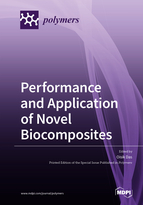Performance and Application of Novel Biocomposites
A special issue of Polymers (ISSN 2073-4360). This special issue belongs to the section "Polymer Applications".
Deadline for manuscript submissions: closed (31 August 2020) | Viewed by 68631
Special Issue Editor
Interests: flammability of polymeric composites and bio-based materials; biocomposites development; polymers; biochar; pyrolysis; nanoindentation; natural fibres
Special Issues, Collections and Topics in MDPI journals
Special Issue Information
Dear Colleagues,
Sustainability and safety along with strength are the cornerstones for the development of contemporary industrial products. Due to this, biocomposite materials are undergoing steady development which can be applied for numerous applications. However, biocomposites often times suffer from poor mechanical properties and are very susceptible to fire. As a consequence, new research should be devised in order to manufacture biocomposites with superior performance properties. This could be achieved using novel biobased reinforcements and natural polymer resins having attractive material characteristics.
The Special Issue, entitled “Performance and Application of Novel Biocomposites”, would serve as a platform for addressing the developments made in the field of polymer composites where innovative methods, materials, and processing are employed to enhance mechanical, fire, and functional properties. Potential topics include but are not limited to the following: carbon-based materials (e.g., biochar and graphene), self-healing composites, flammability, nanoindentation, biopolymers (e.g., gluten), new processing and testing techniques, and fiber surface modifications.
Papers are published upon acceptance, regardless of the Special Issue publication date.
Prof. Dr. Oisik Das
Guest Editor
Manuscript Submission Information
Manuscripts should be submitted online at www.mdpi.com by registering and logging in to this website. Once you are registered, click here to go to the submission form. Manuscripts can be submitted until the deadline. All submissions that pass pre-check are peer-reviewed. Accepted papers will be published continuously in the journal (as soon as accepted) and will be listed together on the special issue website. Research articles, review articles as well as short communications are invited. For planned papers, a title and short abstract (about 100 words) can be sent to the Editorial Office for announcement on this website.
Submitted manuscripts should not have been published previously, nor be under consideration for publication elsewhere (except conference proceedings papers). All manuscripts are thoroughly refereed through a single-blind peer-review process. A guide for authors and other relevant information for submission of manuscripts is available on the Instructions for Authors page. Polymers is an international peer-reviewed open access semimonthly journal published by MDPI.
Please visit the Instructions for Authors page before submitting a manuscript. The Article Processing Charge (APC) for publication in this open access journal is 2700 CHF (Swiss Francs). Submitted papers should be well formatted and use good English. Authors may use MDPI's English editing service prior to publication or during author revisions.
Keywords
- biocomposites
- flammability
- carbon-based materials
- self-healing
- processing







